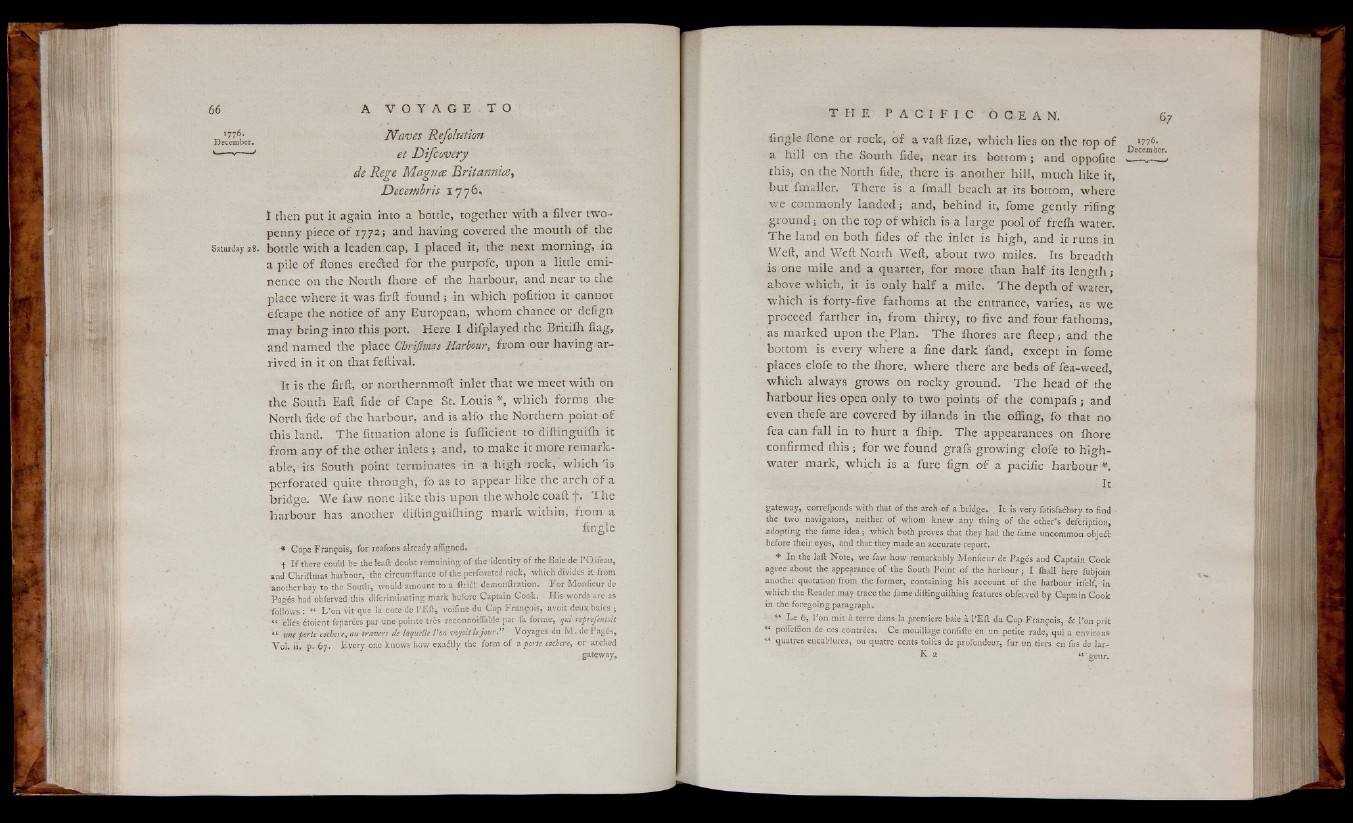
_ 'Decnem6b'e r. N aves ReCoIution
1— *— ’ et Difcovery
de Rege M agna Britannia-,
Decembris 1776,
Ï then put it again into a bottle, together with a filver twopenny
piece of 1772 ; and having covered the mouth of the
Saturday 28. bottle with a leaden.cap, I placed it, the next morning, in
a pile of ñones eretfted for the purpofe, upon a little eminence
on the North ihore of the harbour, and near to the
place where it was firft found ; in which pofition it cannot
efcape the notice of any European, whom chance or defign
may bring into this port. Here I difplayed the Britifh flag,
and named the place Chrijlmas Harbour, from our having arrived
in it on that feftival.
It is the firft, or northernmoft inlet that we meet with on
the South Eaft fide of Cape St. Louis *, which forms the
North fide of the harbour, and is alfo the Northern point of
this land. The fituation alone is fufficient to diftinguiih it
from any of the other inlets ; and, to make it more remarkable,
iis South point terminates in a high rock, which fis
perforated quite through, fo as to appear like the arch of a
bridge. W e faw none like this upon the whole coaft f . The
harbour has another diftinguiihing mark within, from a
fingle
* Cape Francois, for reafons already affigned.
f I f there could be theieaft doubt remaining of the Identity of the Baie de l’Qifeau,
and Chriftmas harbour, the circumftanée Of the perforated rock, which divides it from
■another bay to the South, would amount to a ftriil demonftratlon. For Montreur de
Pages had obferved this difcriminating mark before Captain Cook. His words are as
follows : “ L ’on vit que la cote de l ’ifft, voifine du Cap François, avoit deux baies ;
« elles étoient feparées par une pointe tres reconnoiilable par fa forme, qui reprefentoit
« tme porte cachere,-au travers de laquelle l ’on voyait le jour.” Voyages du M. de Pages,
Vol. ii. p. 67. Every one knows how exaétly the form of a porte cochero, or arched
gateway,
fingle flone or rock, of a vaft fize, which lies on the top of
a hill on the South fide, near its bottom ; and oppofite
this, on thé North fide, there is another hill, much like it,
but fmaller. There is a fmall beach at its bottom, where
we commonly landed; and, behind it, fome gently riling
ground; on the top of which is a large pool of frelh water.
The land on both fides of the inlet is high, and it runs in
Weft, and Weft North Weft, about two miles. Its breadth
is one mile and a quarter, for more than half its length;
above which, it is-only half a mile. The depth of water,
which is forty-five fathoms at the entrance, varies, as we
proceed farther in, from thirty, to five and four fathoms,
as marked upon the Plan. The Ihores are fteep; and the
bottom is every where a fine dark fand, except in fome
places clofe to the Ihore, where there are beds of fea-weed,
Which always grows on rocky ground. The head of the
harbour lies open only to two points of the compafs ; and
even thefe are covered by iflands in the , offing, fo that no
fea can fall in to hurt a ihip. The appearances on ihore
confirmed this ; for we found grafs growing dole to high-
water mark, which is a fure fign of a pacific harbour *.
It
1776.
December.
.gateway, correfponds with tbat of the arch of a .bridge. It is very fatlsfaaory to find ,
the two navigators, neither o f whom knew, any thing of the other’ s defcription,
' adopting the fame idea ; which both proves that they had the fame uncommon objefl
before their eyes, and that they made an accurate report.
* In the laft Note, we faw how remarkably Moniteur de Pages and Captain Cook
agree about the appearance of the South Point of the harbqur ; I fhpll here fubjoln
another quotation from the former, containing his account o f the harbour itfelf,-in
which the Reader may trace the fame diftinguiihing features obferved by Captain Cook
in the foregoing paragraph.
■ “ Le 6, l’on mit à terre, dans la premiere baie à l’Eft du Cap François, & l’on prit
« poffeffion de ces contrées. . Ce mouillage confifte en un petite rade, qui a environs
" quatres encablures, ou quatre cents toifes de profondeur, fur un tiers en fus de lar-
L 2 T gsur.